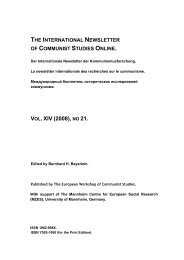11RXNdQ
11RXNdQ
11RXNdQ
You also want an ePaper? Increase the reach of your titles
YUMPU automatically turns print PDFs into web optimized ePapers that Google loves.
Introduction<br />
Remembering Sartre<br />
Azzedine Haddour<br />
I<br />
Sartre wrote this book as a series of essays at a time when colonial empires were<br />
crumbling. His project is twofold: to analyse the discourses of colonialism and<br />
neocolonialism and to argue for the necessity of decolonization. Sartre delineates a<br />
number of what he calls ‘situations’ in which he intervenes to critique the nefarious<br />
effects of these two discourses respectively on the colonized and the Third World. First,<br />
in his review of Cartier-Bresson’s photographs of China, he announces the end of the<br />
picturesque. Secondly, he criticizes the political structures of an old colonial France<br />
governed by an ideology constructed in the nineteenth century, structures that perpetuated<br />
political instability and demanded urgent modernization. Thirdly, he rallies behind an<br />
incendiary Third-Worldism, engaging with the writings and political thought of Memmi,<br />
Fanon and Lumumba. Let us first deal with the specificities of each of the essays before<br />
re-situating Sartre within the field of postcolonial studies.<br />
Sartre wrote ‘From One China to Another’ as a preface to Cartier-Bresson’s work. 1<br />
Borne out of war, the picturesque, Sartre reminds us, cannot comprehend difference.<br />
Sartre prefigures the arguments of Roland Barthes in ‘Myth Today’ and Edward Said in<br />
Orientalism, i.e., the fabricated quality of the mythic idea and its orientalizing intent.<br />
Sartre writes: ‘[The photographers] seek out a Chinese who looks more Chinese than the<br />
others; in the end they find one. They make him adopt a typically Chinese pose and<br />
surround him with chinoiseries. What have they captured on film? One Chinaman? No …<br />
the Idea of what is Chinese’ (this volume, p. 18). Taken at high speed, Cartier-Bresson’s<br />
snapshots cannot indulge in ‘gossip’ and do not even have the time to be superficial. In<br />
Sartre’s view, the Chinese photographed by Cartier-Bresson do not look Chinese enough.<br />
Sartre thanks him for his ‘nominalism’ (this volume, p. 19), for demystifying the<br />
picturesque that takes refuge in the convention of language and hides behind mythic<br />
concepts. The photography of Cartier-Bresson, Sartre concludes, ‘announces the end of<br />
tourism. It gently teaches us, without useless pathos, that poverty has lost its picturesque<br />
quality and will never recover it.’<br />
‘Colonialism is a System’ was originally given as a speech at Wagram on 27 January<br />
1956. 2 Sartre, who was in favour of peace, protested against France’s policy of<br />
pacification during the Algerian war. He warned against the mystification of<br />
neocolonialism and undertook a detailed analysis of French colonialism in Algeria, a<br />
system put in place in the nineteenth century, supported and maintained by liberal<br />
ideology. The theory of imperialism, Sartre contends, was not formulated by Lenin but by<br />
the liberal ideologue Jules Ferry.




